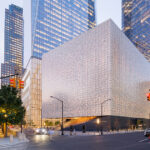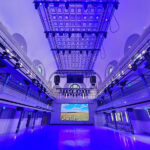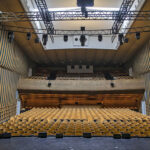 It’s cruise ship month here at PLSN, and I’m onboard. When the Swami called to give me my marching orders, I found myself staring at the bow of the Carnival Liberty.
It’s cruise ship month here at PLSN, and I’m onboard. When the Swami called to give me my marching orders, I found myself staring at the bow of the Carnival Liberty.
I want to be very clear on this next statement.
This is a very big boat.
Actually, that’s not right. I don’t think I’m allowed to call it a boat. Let’s start over.
This is an extremely large ship.
How large, you ask? How about three football fields? That do anything for you? Nine hundred fifty-two feet long, and 116 feet at its widest, the newest addition to Carnival Cruise Line’s fleet tips the scales at 110,000 tons.
| Partial Equipment List 120 Barco DLite 7 Outdoor LED Panel 1 Barco D320 LED Video Wall Processor 1 Barco D320 Composite/S-Video Input Card 1 Barco D320 SDI Input Card 1 Barco D320 RGB Analog Input Card 1 Custom Graphics Generator PC 1 Extron ISM 482 8-In/2-Out Scaler with Stereo Audio 1 Sony SLV-D550P VHS, DVD & Tuner Combination Unit 1 Adtec Soloist SDI MPEG Player 1 Sanyo VC4594 CCTV Camera 1 AMX Control System 1 AMX AXT-MCP Wired Touchscreen 1 AMX VPN-CP Wireless Touchscreen |
Who cares, right? It’s a big boat, you say. I figured you might say that. So I tracked down Michael Lindauer of Nautilus Entertainment Design (NED) to see if he could show us something onboard the Liberty that we might find intriguing.
Let’s see what he came up with…
Video Adventure on the High Seas
Michael Lindauer: Carnival Cruise Lines wanted to update their outdoor pool areas to create an outdoor amphitheatre, including a large exterior video and audio system for playback of movies, music, videos, live camera, video games and anything else that might entertain their guests. In general, exterior video screens are a new addition to ships with the first being installed by a sister company, Princess Cruise Lines, in 2004. Carnival, which already had similar plans in development, quickly followed. They chose to adapt the pool area of the Carnival Liberty, which was already under construction at the Fincantieri Shipyard in Monfalcone, Italy.
PLSN: That’s a mouthful Mike. So how do you know so much about this ship, and how do you pronounce the name of that shipyard?
NED has been involved in the entertainment systems designs for the Carnival Corporation for many years. With that strong relationship in place, they approached us to design and implement the new systems for the Liberty.
We had to move quickly to complete designs, and they had to be based upon the fact that the ship was already quite advanced in general design and physical construction.
We first became involved around June 2004, and the project delivered in July 2005. Due to the way ships are built, the installation went in stages, with the structural installation taking place from Nov. 2004 until Feb. 2005, and the electronics going in just before delivery.
Sounds like a pretty major addition to tack onto an existing project.
It placed some limitations on where cables could be pulled, what space was available for equipment and how much power was available.
Space was probably the biggest concern, as there was inherently not a good location for the screen itself. After consultation with the architect and Carnival management, it was decided to add a section of deck to two levels of the pool area superstructure to provide a suitable location for the screen assembly and support. The weight of the assembly required the lower decks and supporting steel to be strengthened to support the addition.
Hold on just a second there! I’ve installed a TV or two in my day, and I’ve never had to reinforce any superstructures. So how big was this system of yours, and can I get a demo unit for my living room?
The screen is 22 feet wide and almost 12 feet high, with a viewing area of 258 square feet. The overall assembly weight, including screen, audio arrays and steel, weighs in at 27,500 pounds.
And I thought my Trinitron was heavy. I guess it’s a good thing that those ships don’t move very quickly.
Consider the fact that the ship is moving not only forward, but up and down, in rough weather, and is also exposed to heavy vibrations during maneuvering. The mechanical structure and all connections had to take these additional loads into account. The structure is actually designed for almost two times as much gravity and all connections have specific actions taken to combat vibration.
For this case, probably the most critical complication was the harsh, salt air environment. The location of the screen is 100 feet in the air, facing into the wind, on a ship that has the potential to be traveling 25 miles per hour with a strong wind from any direction. This is the most demanding environment that you could think of to install electronics.
All of the LED manufacturers quoted installations on pier sides or in race boat tracks with salt water, which were very good examples of difficult salt air environments. However, these were static installations, where ours was going to be moving through the air at 25 miles per hour, and would face storms and even hurricanes.
 I doubt that there are many manufacturers who would even be willing to attempt that kind of a test. How did you decide on a product for the video wall?
I doubt that there are many manufacturers who would even be willing to attempt that kind of a test. How did you decide on a product for the video wall?
We contacted all of the major LED manufacturers… Daktronics, Mitsubishi, Panasonic, Multimedia, Philips and others. Honestly, all had very strong products for certain applications. However, for our needs, we narrowed the field down to four possibilities, and finally settled on the Barco DLite 7 product.
This product was proven in adverse environments and was the only product at the time which carried a documented IP65 rating, a degree of weatherproofing. Barco also worked with us to provide a test screen, which was installed onboard one of Carnival’s older ships to allow us to test the suitability under real conditions. The test was successful, and is actually still running today.
Now, I know that LEDs are pretty efficient little doodads, but my guess is that a screen with a 25-foot diagonal is not only great for watching the Victoria’s Secret fashion show, but probably takes a little bit of juice to run.
The screen draws a maximum of 30,000 watts and averages 8,500 watts.
Power for the screen is generated from the ship’s main power system, which relies on diesel generators. The power on these ships is three-phase delta power with no neutral. This is a bit different than the delta power that we have on land. It means that it is not possible to use any type of equipment that references neutral in its design. If they do, then the ship’s power monitoring system will register a ground fault and the engineers will insist that the system be shut down, as it’s not possible to know what is a real fault and what is due to the neutral reference.
The only alternative in that situation would be to isolate that system from the main with an isolation transformer. However, this is not a preferable course of action, as the engine department then has no way to monitor if there is a problem.
The LED system has internal power monitoring and switched power supplies for self-protection, and the 120 tiles are distributed across all three phases through fifteen breakers. All source equipment is on a UPS designed for delta power supplies.
I’m glad you brought up the source equipment. You mentioned something about movies and video games earlier. I figured they were just going to show reruns of I Love Lucy all the time.
The content and source is constantly changing. The head-end system includes DVD, MPEG player, live camera, computer input, graphics generator, broadcast feed, as well as connections for external devices…including PlayStations.
This was another challenge that actually did not become apparent until we were in testing stages. Most large-scale LED installations have a single dedicated source.
For instance, the screens in Times Square have content produced specifically for them and play off a single type of source—typically MPEG. On a tour, all screens have the same source programmed per cue. They generally play the same thing every show. Under both situations, the owners can customize the source material and the wall settings to match one another.
In our case, we have no schedule. Movies change weekly, daily or even by the minute. The screen’s usage is completely dependent on the specific cruise, itinerary, special event or special group. So, the screen had to be tuned to a “generic” setting and the crew may have to tweak the settings each day. It’s a bit of a compromise, which took some playing to get right.
The content itself is chosen by Carnival management, and ranges from music videos and live television shows during the day, to Playstation competitions and movies at night.
Big Boat, Big Screen
Huh. So the Liberty’s a very big boat with a very big screen.
I guess all that’s left for me is to see how the accounting department responds to my expense report for this article. (I always seem to run into problems when they get to the umbrella drinks. These are legitimate business expenditures, people!)
Anyhow. Be sure to look up when you’re touring the cruise ship deck on your next family vacation. You might just see some of NED’s work.
Phil Gilbert is a freelance lighting designer/ programmer. He can be reached at pgilbert@plsn.com.


